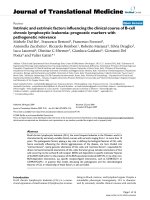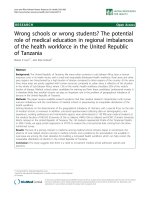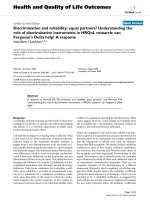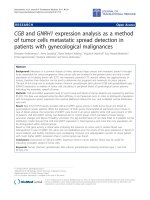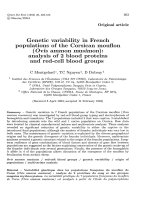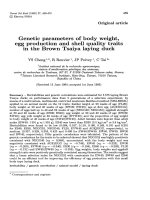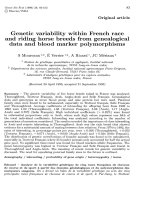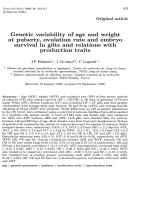Báo cáo sinh học: "Genetic and environmental factors affecting some reproductive traits of Holstein cows in Cuba" ppt
Bạn đang xem bản rút gọn của tài liệu. Xem và tải ngay bản đầy đủ của tài liệu tại đây (850.44 KB, 14 trang )
Original
article
Genetic and environmental factors
affecting some reproductive traits
of Holstein cows in Cuba
A Menendez Buxadera
1
Centro
de
2
L
Dempfle
Mejoramiento Animal, Carretera Central Km
Cotorro, Havana, Cuba;
International Trypanotolerance Center, PMB 14, Banj!al, Gambia
Investigacidn
para el
(Received
6 March
1996; accepted
14
21
1/2,
August 1997)
Summary - A total of 226 651 fertility records of dairy
cows obtained from 1980 to
1988 was studied in order to determine the environmental and genetic factors affecting
the reproductive performance of Holstein cows under Cuban conditions. Only 43.9% of
the inseminated females were pregnant at first service; however, for heifers this value
was 63.1%. The seasonal variability was higher for heifers and for primiparous than for
older lactating cows. The best performance was found from February to April, whereas
during the hot and humid summer (July to September) poorer results were obtained.
Age at calving or number of calvings was another important environmental source of
variation: the earlier the calving the poorer is the next reproductive performance. The
genetic analyses were made within calving number with the REML procedure. For heifers
(226 sires, 45 575 records) the heritability and the genetic coefficient of variation were:
2.26 and 10.94%, 3.24 and 11.24%, and 3.04 and 6.19% for conception rate (CR), numbers
of services per conception (SG) and conception status (CS
1/SG), respectively. For first
calving females (280 sires, 43 647 records) the results were: 1.94 and 15.93%, 3.25 and
12.80%, and 3.47 and 9.47% for CR, SG and CS, respectively. For the second and third
calving, the results were poorer. For the calving interval and days open, the heritabilities
were between 1.86 and 4.64%. The results of SG were selected as the best and more useful
traits showing high genetic correlations (> 0.60) for the same traits in different calving
number.
=
Holstein cattle breed
/ reproduction traits / genetic parameters / tropical
conditions
Résumé - Facteurs génétiques et environnementaux intervenant sur les performances
de reproduction des vaches Holstein à Cuba. Au total 226 651 enregistrements de
fertilité de vaches laitières obtenus de 1980 à 1988 sont analysés en vue de déterminer les
Correspondence and reprints: F M6nissier, Station de g6n6tique quantitative
Inra, 78352 Jouy-en-Josas cedex, France
et
appliqu6e,
et environnementaux intervenant sur les performances de reproduction
de vaches Holstein dans les conditions cubaines. Seulement 43,9 % des femelles inséminées
sont gestantes à la première insémination, alors que pour les génisses ce taux est de 63,1 %.
La variabilité due à la saison appart plus élevée chez les génisses et primipares que chez
les vaches plus âgées. Les meilleurs résultats sont obtenus de février à avril, alors que
les plus mauvais sont observés durant l’été (juillet à septembre), qui est chaud et humide
dans les conditions cubaines. L’âge au vêlage et le rang de vêlage sont aussi d’importantes
sources environnementales de variation. Plus le vêlage est précoce, plus la reproduction
suivante est mauvaise. Les analyses génétiques ont été réalisées intrarang de vêlage en
utilisant une méthode REML. Pour les génisses (226 pères, 45 575 performances), les
héritabilités et coefficients de variation génétiques sont de 2,26 et 10,9l, %, de 3,24 et
11,24 % et de 3,04 et 6,19 % respectivement pour le taux de conception (CR), le nombre
d’inséminations par fécondation (SG) et l’état de gestation (CS
1/SG). Pour les
primipares (280 pères, 43647performances), ces résultats sont de 1, 94 et 15,93 %, de
3,25 et 12,80 % et de 3,47 et 9,47 % respectivement pour CR, SG et CS. Pour les vaches
au deuxième et troisième vêlages, les estimations sont plutôt inférieures. L’intervalle
entre vêlages et la durée entre vêlage et fécondation ont des héritabilités estimées variant
entre 1,86 et 4,64 %. Les résultats relatifs au nombre d’inséminations par gestation (SG)
conduisent à considérer ce critère comme le meilleur et le plus efficace pour la sélection,
manifestant par ailleurs une forte corrélation génétique (> 0, 60) entre rang de vêlage pour
ce critère.
facteurs génétiques
=
race bovine Holstein / performances de
conditions tropicales génétiques
reproduction / paramètres génétiques /
INTRODUCTION
Milk production is the main cattle goal in Cuba. Great amounts of resources
have been used, not only in construction of cattle barns and infrastructure, but
also thousands of Holstein females have been imported from Canada. A national
breeding plan (NBP) was established in 1964, in which artificial insemination (AI)
played an important role in crossbreeding between native Zebu cattle and Holstein
sires. The general strategy and some results of NBP are offered in Anonymous
(1978) and Prada (1984).
The population of purebred Holstein cows is relatively large (more than 100 000
heads) and it is very important to analyze the general performance of all traits
of economic importance in order to improve the national breeding scheme. For
milk production and its constituents, an analysis was made by De los Reyes (1985)
for several environmental factors. The main genetic parameters were reported by
Guerra et al (1987), whereas some aspects on genotypic x environmental interaction
and its role in the estimation of sire breeding value were presented by Men6ndez
Buxadera and Guerra (1981) and Men6ndez Buxadera et al (1989).
According to the results previously mentioned, it could be concluded, regardless
of the stressing environmental factors affecting dairy traits, that a very important
genetic variability exists; therefore a breeding scheme in the Holstein population
could be carried out. In this sense, it will be very useful to determine the
characteristics of reproductive performance of the Holstein breed in Cuba since this
is the most important individual factor affecting cattle production in this country.
For the last 15 years, a great number of papers has been published with respect to
genetic aspects of reproductive performance of dairy cattle (Janson, 1980; Hansen
et al 1983; Jansen, 1986; Weller 1989). In general terms, there is a consensus that
a large number of traits related to reproduction shows low heritability (lower
than 10%), but a high genetic variability. Considering this fact and also the
economic importance of fertility, certain traits of reproductive performance should
be considered in the selection criterion (secondary traits) for a breeding scheme.
Unfortunately, under tropical conditions almost no research related to this topic
has been conducted. For this reason, a study of the genetic and environmental
aspects of reproductive performance of Holstein cattle in Cuba was carried out and
the main results will be presented in this paper.
MATERIALS AND METHODS
Available data
A total of 270 000 individual records of Holstein
cows
calving
from
January
1980
to December 1988 throughout the country was available for this study. These data
sets belong to a system developed at the National Center for Cattle Recording
(CENCOP) to maintain the control of the Holstein as a pure breed but also some
important reproductive data have been collected:
date of pregnancy and calving;
registration number of the cows and sire of the calf;
number of insemination services in which the cow was pregnant;
herd code;
results of calving:
abortion - if gestation period
stillbirth or not - if gestation
sex of the calf - no abortion.
Taking
into account the data
less than 260 days;
period was between 260 and 295
was
available,
a
procedure
was
permanent file of identification of each animal maintained
days;
conducted in which the
at CENCOP
in order to obtain the
was
merged
with the reproductive file mentioned previously
registration
number of the sire of the cow and birth date of the cow.
As a consequence of this process, the new data set has a total of 232 291 records
with the information of each cow.
The number of calvings was not available in the original file, so it was decided
to generate according to age at calving. Table I shows the general characteristics
of the definitive data set.
Only Holstein sires born in Cuba and with a minimum of 20 daughters in a
specific calving and distributed in at least five herds were considered for genetic
studies; however the exact figures will be presented in the respective tables.
l7raits
The following reproductive traits were studied:
number of services per pregnancy
conception status
rate of conception for first
services
SGi;
i
CS = 100 ! (1/SG
);
i
i
CR = ( 100 to pregnant at first
service, 0 otherwise);
calving interval (in days),
(i :
i
CI number of calving);
interval between calving and pregnancy (in days) DO (i: number of calving).
i
Records ending with an abortion, as well as records outside of the range 300-730
days for CI and 20-450 days for DO were deleted. The first three Cl and DO
i
i
were analyzed. With the logical exception of DO and Ci all reproductive traits
i
,
i
are determined for any value of i (between 0 and 4).
Management systems
The
organization of cattle production in Cuba is mainly based on large state
enterprises (more than 10 000 heads), which are fairly uniform with respect to
structure and organization. The dairy units have around 200 females which are
milked twice daily with milking machines. From 10 am to 4 pm, all cows are kept
indoors where they receive forage or silage and water, and graze the rest of the
time. Inseminations are conducted early in the morning or late at night and the
service bulls are selected yearly according to a plan for each enterprise. As a rule,
between two and five service bulls are used at the same time in each herd. Pregnancy
diagnosis is made by rectal palpation (after 60-90 days of insemination, by a specific
All the individual records of each animal are maintained at the unit,
month an official inspector from CENCOP visits the herd in order to
estimate milk yield of each cow in each milking. All data are sent to CENCOP once
a month.
technician).
and
once a
Statistical
procedures
Two different statistical
analyses
were
performed. The first
model
was as
follows:
where p is the general mean; H is a fixed effect of a combination of herd and
i
year which was absorbed; M is a fixed effect of month of calving (or month of
j
pregnancy) for j= 1, ..12; A,! is a fixed effect of number of calvings (or age at
pregnancy) for k = 1, ..4; ei!!1 is a random residual.
This model was applied in order to determine the magnitude of the fixed effects
of certain environmental factors affecting each dependent variable. Age at calving
was considered to be a factor. Solutions for age and months were estimated after
constraining the last level of each factor to zero.
The estimation of genetic parameters was the objective of the second mixed
model which has the following matrix notation:
where: Y is
a vector of observations; (3 is a vector of fixed effects including age and
herd-year-season of calving (natural trimester); s is as vector of random sire effects
and e is a vector of random residuals, and X and Z are incidence matrices.
The following assumptions were made:
The
e
QSand Qwere
estimated by restricted maximum likelihood (REML)
The general statistical properties and description
of this method of variance components are well illustrated by Kennedy (1981),
Dempfle et al (1983) and Lin and McAllister (1984). The variance components
estimated for SG were used for breeding value estimation (EBV) through the BLUP
i
procedure with a mixed model similar to model 2, but with the age at calving as a
covariable. The computer program was developed by Caleyo (1989) and was applied
within calving number. The relationship matrix was not considered.
The genetic correlation (Rg) between SG was estimated by two methods. The
i
first procedure was published by Calo et al (1973) and was very well presented by
Blanchard et al (1983) and is based on the weighted covariance between estimated
;
I
EBV in that case, only those sires with more than 70 effective daughters on
each calving were considered. The second estimation of Rg was based in a REML
procedure with a model similar to model 2 but using the expected components of the
variance of a new trait SG
T (SG + SG In order to fulfill these conditions, a
i i+i
).
new data set was formed with those cows with records on SG in adjacent calvings.
i
(Patterson and Thompson, 1971).
=
RESULTS
The distribution of data for number of services per conception for different calvings
is shown in table II. Only 43.86% of the females were pregnant at first service (this
result is equivalent to conception rate to first insemination) and gives clear evidence
of the low reproductive performance of Holstein cattle under Cuban conditions. The
results for heifers are quite acceptable; however, for lactating females, a dramatic
breakdown is observed in fertility rate.
Environmental effects
The results of the statistical analysis according to model 1 show very highly
significant effects (P < 0.001) for the different factors included; however, the
determination coefficient (R of the model was between 9.2 and 12.4% for all
)
2
traits evaluated in heifers and first calving stages. For older animals (more than
two calvings) the R was between 3.6 and 26.9%. In all cases, the highest R was
2
z
obtained for SG and the lowest for CR
i
.
i
The solutions for month effects on heifer, first, second and third calving conception status (CS are shown in figure 1. Although only CS is presented, the
i
)
i
general pattern was the same for the rest of the characters. The best results were
obtained in March and April (lower SG and higher CR and CS whereas the
i
,
i
),
i
poorest fertility rate was in September and October. Plotting climatological data
on the same figure shows the very evident relationship between the hot and humid
summer and a lower reproductive performance, and the relationship between the
winter and the less humid period from January to April and the best results for
CSi, CRi and SGi.
Concerning days open (DO and calving interval (CI month effects were the
)
i
),
i
same as for CS CR and SG which was as expected. However, the most important
,
ii
,
i
i
i
component of DO and CI is the interval between calvings and first service and
these characters were not available in our data sets, so no more details can be
provided on these traits.
The year effect was highly significant (P < 0.001) for the main traits studied.
The solutions for each character expressed as deviations from the last year are
shown in table III. In general terms, during the period of time represented in our
data sets, a positive trend in reproductive performance of our Holstein females was
found; however, even with these changes an optimum or near optimum level of
fertility is never reached. The analysis of the effect of years was made also within
calving number and the same pattern was found except in heifers, which showed
an opposite trend during the period.
number of calving on the dependent variables was highly
This was expected according to the information offered
in table II. In general, the reproductive performance decreases as the number of
calving increases as a consequence of cumulative stress due to lactation and previous
reproductive disorders. When data were analyzed within calving number, the trend
of age effects was negative, so the younger the calving is reached the poorer is the
next reproductive performance of lactating females.
The effect of age
significant (P
<
or
0.001).
Genetic effects
The results of the mixed model show a highly significant effect (P < 0.001) of
sires for all traits. The heritability (h for each character and variance component
)
2
estimated by REML are presented in table IV, where the additive genetic coefficient
of variation (CVg) is included.
i
CR and CS the genetic variance was more or less the same for different
,
i
with the exception of second calving in which an unexpected result was
found. For DO and Cl an opposite pattern was found and a clear reduction in
i
,
i
the genetic variance was obtained for older cows compared to primiparous cows.
The genetic variance for SG increased 2.8 times for first calving with respect to
i
results in heifers; however, for second and third calving the estimates were lower.
The total phenotypic variance increases when estimating in heifers to third calving.
2
As a consequence of these particular trends in both variance components, the h
for all traits was higher for heifers and first calving. The same results were obtained
for CVg.
For
calvings,
Concerning the number of reproductive characters available it would be necessary
to perform a certain type of discrimination. In this context, it will be very important
2
to take into account not only the value of h and CVg, but other peculiarities,
as facilities for recording and multiple objectives in the principal factors
limiting the level of productivity of populations. In this sense, it will be very
useful to conduct a relative comparison among some fertility parameters in different
populations of Holstein cows (table V). Before 100 days after calving there is not
a clear difference among the populations of percentage of females inseminated,
which is very important to consider because the climatological conditions, systems
of management and level of feeding are quite different in the three countries. The
real problems emerge when we look at the percentage of pregnant females before
100 days after calving. According to this complete relative comparison and taking
into account the results of Caral et al (1984), who reported that only 43% of cows
not pregnant at first service presented second heat in a normal period of time,
it can be concluded that at least in female Holstein populations, limiting factors
are closely related to the number of services per conception (SG Together with
).
i
this advantage, this character is related to first service conception rate, is easy to
record under field conditions in heifers and lactating cows and, furthermore, it will
be useful for other purposes such as sire fertility evaluation; thus, SG will be the
i
preferred trait in our breeding objectives. However, it is necessary to determine the
i
relationship between SG in different types of females.
such
this study (table VI) shows that there are medium to high
associations between SG at different calvings. The results were poorer with
i
genetic
non-consecutive records in comparison to adjacent ones. The Rg estimated by the
covariance of EBV was higher than the results of REML; however, the differences
I
would not suggest that the same genetic bases exist for this trait measured at
different stages of the reproductive life of the cows.
The
general pattern of
DISCUSSION
Unfortunately, there are not many references available on reproductive performance
of Holstein cattle in the tropics. However, it is obvious from our results that the level
is very low (see table II). According to Roman Ponce (1992) this is the general trend
in tropical conditions and this low fertility rate of cattle represents the principal
limiting factor affecting the productivity of cattle in these regions.
The seasonal variation obtained in these results is similar to those patterns
in the subtropical regions of Mexico and Florida (Ingraham et al, 1974;
Thatcher et al, 1984) and in the very hot and arid environmental conditions of
Arizona (Monty, 1984) and Israel (Heimann, 1982; Ron et al, 1984). Many studies
have been conducted in order to study the role of heat stress in the summer on the
productive and reproductive performances of cattle in that area, with the objective
of reducing the depressive effects with a new management system. According to
Thatcher (1974), Thatcher et al (1984), Monty (1984) and Wazdauskas et al (1986),
the maximum temperature after insemination is one of the main factors affecting
the reproductive performance of Bos taurus cattle in tropical countries. High
temperature causes a complete hormonal imbalance, which in turn may change the
flow of nutrients to the uterus, and at the same time raises the uterus temperature.
This mechanism contributes to creating a more hostile ’uterus environment’ and
increases the probability of fertility failure or subsequent embryo death. In figure 1 it
can be observed that the magnitude of the month effect is very intense for all cattle
categories; however, it would be evident that this environmental stress was twice
as high for heifers and first calving females as for the rest of the cows. In fact, this
behavior is contradictory in the literature (Thatcher, 1974; Thatcher et al, 1984),
according to which the older lactating females must be more variable and more
sensitive to heat stress. It is possible to speculate on this apparent paradox. When
an adequate level of feeding and management is available, the live weight at first
calving of a medium Holstein female is 500 kg, ie, 80% of the adult weight. Under
reported
conditions, the variability of fertility traits in heifers and first calving females
be less affected by heat stress; however, this is very far from our conditions.
The developement and body weight curves of Holstein females in Cuba are poorer
than those expected for this breed (Men6ndez Buxadera et al, 1983); on average our
females reach approximately 400 kg live weight in the middle of first calving, which
means that this type of animal is less mature (in the sense of weight). Therefore, a
higher percentage of the nutrients received must be used for the growing process.
This mechanism could account for the higher variability and sensitivity of younger
females under our conditions.
All these environmental factors require a more detailed and profound research
in order to determine the physiological mechanism. However, the practical consequences of the seasonal variation in reproductive performance of Holstein females
under our tropical conditions could be used. For instance, these results show that
from September to January around 60% of the cows (not heifers) calving in that
period corresponded to the season of higher fertility rate (see fig 1). According to
this pattern, it would be highly recommended to inseminate the majority of the
females from January to April with semen of Holstein sires of higher breeding value
for milk production (principal traits in our breeding scheme). The preliminary estimates of such a policy show an improvement of not less than 20% in genetic
potential in our female population with respect to the normal practice of bulls in
service all year round.
2
According to our results it was clear that the hfor different fertility traits were
low (< 5%) and similar to many reports on this subject (see review of Men6ndez
Buxadera, 1993); however, the genetic variability (table IV) was higher than most
of the results in the literature (see Janson, 1980; Berger et al, 1981; Raheja et al,
1989 for SG and Baptist and Gravert, 1973; Janson, 1980; Jansen, 1986 for nonreturn rate as a trait related to CR). This is due to the reduced culling rate applied
in our female population, so these data show a complete picture of the real genetic
variability in the reproductive performance of Holstein cattle under the tropical
conditions of Cuba. The potential of this variability has not been considered by
2
many researchers on account of the low h value. According to Maijala (1987) this
is a pessimistic point of view regarding the possibilities of genetic improvement for
fertility traits.
2
For DO; and CI there was a clear reducing hpattern when the number of
i
increased. In fact, this trend is contrary to the results published by Berger
calving
et al (1981), Hansen et al (1983), Jansen (1986) and Strandberg and Danell (1988)
who obtained a small increase in h and CVg in older females. For the rest of the
2
traits it was evident that these genetic parameters were higher in the first two stages
(heifer and first calving), which is in correspondence to Van Raden et al (1987),
Raheja et al (1989) and Weller (1989). The results for the second calving were quite
low and no clear explanation was found.
As a matter of fact, the general pattern for higher variability in younger females
in comparison to multiparous cows could be a very important advantage in our
breeding scheme, since the EBV for characters of the reproductive complex must be
determined as early as possible, and higher genetic variability is equivalent to major
possibilities for selection and breeding. This is true only if the traits evaluated in
heifers and first calving females were in close relationship with the same characters
in older cows.
such
can
The information available
that
is contradictory. European reports
showed that the same reproductive characters in both types of females present the same genetic base so the results of
heifers and primiparous cows can be used for sire evaluations. Another recommendation was made by North American researchers (Hansen et al, 1983; Raheja et al,
1989; Van Raden et al, 1989) who reported lower genetic correlations (Rg < 0.30)
although the tendency was the same.
i
According to our results (table VI) the genetic correlation (Rg) for SG in
different calvings was higher than 0.60 when Rg was estimated by the weighted
covariance between EBV of the sire, whereas Rg > 0.49 when the REML procedure
was used. Both estimates are difficult to compare because the value of Rg depends
on the quality of the data set. However, great differences were not observed. Our
point of view is in favor of the results obtained through the EBV, of the sire, because
in REML the same design matrix was used and the computing requirement was
on
subject
(Janson, 1980; Distl, 1982; Jansen, 1986)
greater.
results it is possible to conclude that the same genetic bases
fertility traits measured in different stages of the reproductive
life of cows. This aspect will be very important for sire evaluation purposes since
the records of heifers and first calving could be used in this sense.
According
to
our
exist between certain
CONCLUSIONS
This study shows positive yearly trends in the level of reproductive performance of
Holstein cattle under Cuban conditions, nevertheless, the general mean was quite
low. Calving number and month of calving were the principal environmental factors
affecting the fertility rate of Holstein females; this aspect was more critical in heifers
and primiparous in comparison to older lactating cows. According to these results
the best performance was achieved from February to April, corresponding to the
winter season, while during the hot and humid summer (July to September) very
poor results were obtained. This seasonal pattern must be interpreted as a general
reproductive behavior of Holstein cattle in the tropics, which could be used under
practical conditions.
From a breeding point of view, our study confirms that the h of the characters
2
corresponding to the reproductive complex shows the expected low value (h< 5%).
2
However, the genetic coefficient of variation was higher than the value reported
for developed and temperate countries (see Menendez Buxadera, 1993), so plenty
of space is available for breeding. The number of services per conception (sG
)
i
was selected as the character more related to our limiting factor affecting the
i
reproductive performance of this breed under tropical conditions. Furthermore, SC
could be used for various purposes and it will be possible to measure this at an early
i
age (heifers). In this sense, the relationship between SG in heifers and first calving
females was 0.60 and higher than the 0.88 found between older cows, which allows
us to use all information available for breeding value estimation of AI sires. Taking
into account that the procedures used for Rg estimation could be affected by some
bias, it is highly recommended to use a more powerful statistical procedure such as
an individual multitrait animal model, with different matrix design, although the
computing demand will be higher.
ACKNOWLEDGMENT
The authors wish to express their gratitude to their colleague F M6nissier (Inra, SGQA,
F 78352 Jouy-en-Josas cedex, France) for his valuable help during the process of publication of this article.
REFERENCES
Selection program for dairy and beef production through Artificial
Insemination in Cuba. In: Breeding and Artificial Insemination, FAO/SIDA Seminar,
30 October, 1978, Habana, Cuba
Baptist Von R, Gravert HO (1973) Die Fruchtbarkeit der Tochter in der Bullen Selection.
1
Zuchtung 45, 339-411
Berger PJ, Shanks RD, Freeman AE, Laben RC (1981) Genetic aspects of milk yield and
reproductive performance. J Dairy Sci 64, 114-126
Blanchard PJ, Everett RW, Searle SR (1983) Estimation of genetic trends and correlations for Jersey cattle. J Dairy Sci 66, 1947-1954
Caleyo M (1989) Un programa para estimaciones BLUP del valor gen6tico de los sementales. VIII Jornada CIMA, November 1989, Cotorro, La Habana, Cuba
Calo LL, McDowell RE, Van Vleck LD, Miller PD (1973) Genetic aspects of beef production among Holstein-Friesians pedigree selected for milk production. J Anim Sci
Anonymous (1978)
37, 676-682
J, Iglesias C, Martinez G, Solano R (1984). Influencia del numero de parto en el
periodo intercelo y distribuci6n anual de partos en ganado Holstein. In: Reproduction
des ruminants en zone tropicale (P Chemineau, D Gauthier, J Thimonier, eds), 8-10
juin 1983, Pointe-h-Pitre (FWI). Les Colloques de L’INRA no 20, 491 (abstract), Inra
Caral
Versailles
De los Reyes A (1985) Causas de variaci6n no gen6ticas que afectan la producci6n del
ganado Holstein y estimaci6n de factores de ajuste por edad. Tesis Doctor en Ciencias,
La Habana, Cuba
Dempfle L, Hagger C, Schneeberger M (1983) On the estimation of genetic parameters
via variance components. Genet Sel Evol 15, 425-444
Distl 0 (1982) Selection for fertility traits. Proc 2nd World Cong Genet Appl Liv Prod,
4-8 October 1982, Madrid, Spain, Vol 7, 580-585, Editorial Garsi, Madrid
Foote RH (1978) Reproductive performance and problems in New York dairy herds. Search
Agric Anim Sci 8, 18
Guerra D, Cordovi J, de los Reyes A (1987) Parimetros gen6ticos de las primeras tres
lactancias en vacas Holstein. II Jornada ACPA, mayo 29-30, 1987, Ciudad de Habana,
Cuba
Hansen LB, Freeman AE, Berger PJ (1983) Association of heifer fertility with cow
fertility and yield in dairy cattle. Dairy Sci 66, 306-314
Heiman MM (1982) Breeding Israeli Holstein. Holstein Herdbook, Summary of 1982 milk
and butterfat production
Ingraham RM, Gillette DD, Wagner WD (1974) Relationship of temperature and humidity to conception rate of Holstein cows in subtropical climate. J Dairy Sci 57, 476-481
Jansen J (1986) Studies of fertility in dairy cattle on analysis of AI data. Wageningen
Lands, PhD Thesis, The Netherlands
Janson L (1980) Studies on fertility traits in Swedish dairy cattle. Swedish Univ Agric
Sci, Genetics Dept, report 45
Kennedy BW (1981) Variance component estimation and prediction of breeding values.
Can J Genet Cytol 23, 565-578
Kruif A de (1975) An investigation of the parameters which determine the fertility of a
cattle population and some factors which influence these parameters. Tijdschr Dierg
100, 1089-1098
CY, McAllister AJ (1984) Monte Carlo comparison of four methods for estimation of
genetic parameters in the univariate case. J Dairy Sci 67, 2389-2398
Maijala K (1987) Genetic control of reproduction and lactation in ruminants. J Anim
Breed Genet 104, 53-63
Lin
Menendez Buxadera A (1988) Importancia de la interacci6n genotipo-ambiente en la
evaluaci6n de sementales lecheros. Boletin Resefia, CIMA 6
Menendez Buxadera A (1993) Variacion genetica del comportamiento reproductivo en el
vacuno: revision blibiographica. Rev Cubana Reprod Animal 19, 3-53
Menendez Buxadera A, Guerra D (1981) Relaci6n entre el valor gen6tico de sementales
Holstein evaluados en Cuba, Canada y Mexico, Proc ALPA 16, 161
Menendez Buxadera A, P6rez B, Valle E, Rodriguez N, Herrera R, Varela 0 (1983)
Crecimiento y desarrollo de la hembra Holstein en Cuba. IV Reun ACPA 1983,
69-89
Menendez Buxadera A, de los Reyes A, Guerra D, Cordovi J (1989). Genetic variability
of milk production from Holstein cows according to the level of milk yield of the herd.
Cub J Agric Sci 23, 9-15
Monty de Jr (1984) Early embryo death in cattle during thermal stress. In: Reproduction
des ruminants en zone tropicale (P Chemineau, D Gauthier, J Thimonier, eds), 8-10
juin 1983, Pointe-h-Pitre (FWI). Les Colloques de L’Inra no 20, 285-298, Inra Versailles
Patterson HD, Thompson R (1971) Recovery of interblock information when block sizes
are unequal. Biometrika 58, 545-554
Prada N (1984) Programa nacional de mejoramiento gen6tico vacuno. Rev ACPA 3, 20-26
Raheja KL, Burnside EB, Schaeffer LR (1989) Heifers fertility and its relationship with
cow fertility and production traits in Holstein dairy cattle. J Dairy Sci 72, 2625-2629
Roman Ponce H (1992) Reproducci6n y manejo reproductivo de los bovinos productores
de leche y carne en el tropico. In: Avances en la produccion de leche y carne en el
Tropico Americano (Ferndndez-Boca, ed), Santiago de Chile, 1992, § IV 131-168, FAO
Ron M, Bar Anan R, Wiggans G (1984) Factors affecting conception rate of Israeli
Holstein cattle. J Dairy Sci 67, 854-860
Strandberg E, Danell B (1988) Genetic and phenotypic parameters for production and
days open period in the first three lactations of Swedish dairy cattle. Proc VI World
Cong Anim Prod, Genetic section, June 27-July 1, 1988, Helsinki
Thatcher WW (1974) Effects of season, climate and temperature on reproduction and
lactation. J Dairy Sci 5, 360-368
Thatcher WW, Badinga L, Collier RJ, Mead MM, Wilcox CJ (1984) Thermal stress
effects on the bovine conceptus: early and late pregnancy. In: Reproduction des
ruminants en zone tropicale (P Chemineau, D Gauthier, J Thimonier, eds), 8-10 juin
1983, Pointe-h-Pitre (FWI). Les Colloques de L’INRA no 20, 265-284, Inra Versailles
Van Raden PM, Freeman AE, Berger PJ (1987) Relationship among production and
reproduction in nulliparous and first lactation Holstein cattle. 82th Meet ADSA,
June 21-24, 1987, Columbia
Wazdauskas FC, Whittier WD, Vinson WE, Pearson RE (1986) Evaluation of reproductive efficiency of dairy cattle with emphasis on timing of breeding. J Dairy Sci 69,
290-297
Weller JJ (1989) Genetic analysis of fertility traits in Israeli dairy cattle. J Dairy Sci 72,
2644-2650.

